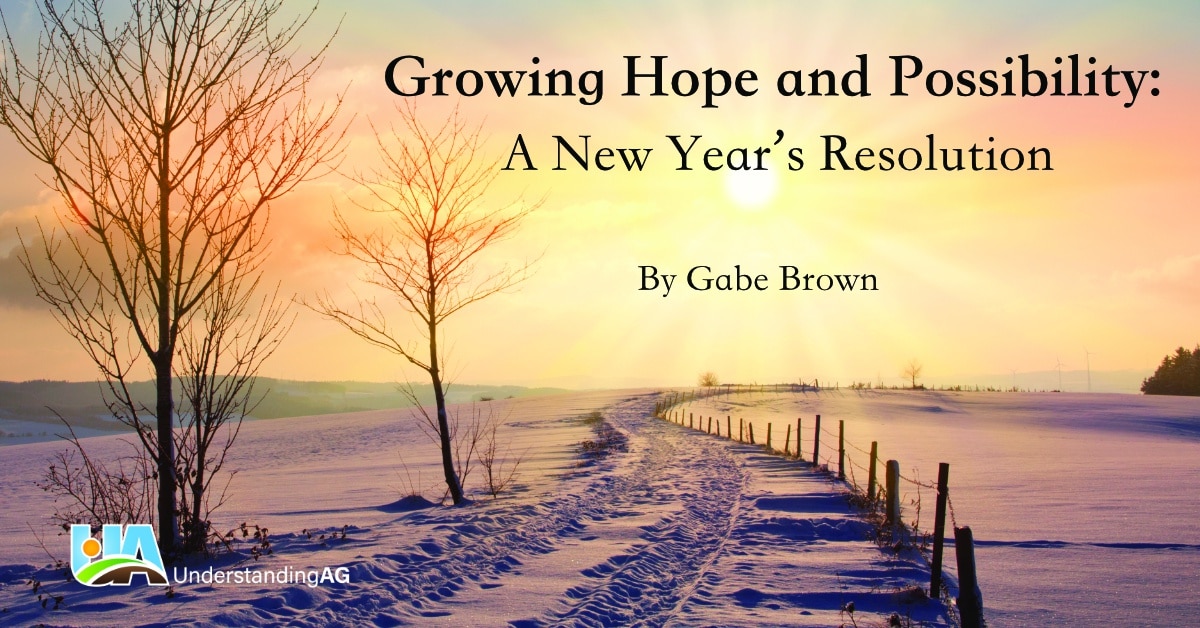
In my last post, I wrote about regenerative agriculture’s Christmas gift for all and how the hope of regenerative agriculture provides “Common Ground for Common Good.”
I genuinely believe that in this New Year, and on this common ground, sprouts real hope and possibility—IF we resolve to grow regeneratively together.
I believe this because every day, our Understanding Ag team gets to witness the positive impact of regenerative agriculture in the lives and on land of the hundreds of farmers and ranchers we work with. When a producer has that “ah-ha” moment and changes the way he or she SEES things and then, as Shane says, becomes intentional in applying the principles and rules to drive the processes—good things happen.
Water infiltrates, soil function improves, life returns to the farm and, along with it, profitability and, probably most important, happiness and quality of life! There are too many success stories to mention them all but I will highlight a couple of them here.
The Schnuele Ranch
Ben Schnuele and his family ranch in south central Nebraska. Ben first contacted Understanding Ag just over two years ago. His family was facing a tough financial situation brought about by years of high input costs and depressed commodity prices. Ben attended a Soil Health Academy and quickly changed the way he saw things. He realized that it was up to him. He had to become intentional. He went home and got to work putting what he had learned into practice.
Knowing the importance of continuing his education Ben attended a second SHA a year later. Fast forward to today, and Ben is harvesting some of the benefits of growing regeneratively. Increased ecosystem function has brought more and better forage for his cattle and has resulted in lower input costs, which equates to a much-improved financial situation. You can read more of Ben’s story here.
The Bock Farm
The plains of northern North Dakota can be a rather harsh environment to farm in. Over the years, Brandon Bock managed to build a profitable operation, balancing limited moisture and a 110-day growing season. However, Brandon knew that model wasn’t sustainable. He watched as saline areas in fields grew larger each year. His input costs increased while commodity prices remained stagnant and he felt depressed each time he sprayed chemicals. He desired something better for himself and his family.
Brandon reached out to us, and we explained that education was the key. Soon thereafter, he and his wife attended a Soil Health Academy. Importantly, they came with open minds and a desire to learn. They were shown a way to work with nature instead of against her—a way to ensure a farming future for their two children, should they so choose.
They learned about solar energy, soil life and ecosystem function. They took that knowledge and “became very intentional.” Despite the short growing season, every one of their cropland acres now has a cover crop seeded on it following harvest of the cash crop. They also adjusted their crop rotation, doing the unthinkable by removing soybeans when they learned about carbon-to-nitrogen ratios.
Despite suffering a D3 drought in 2021, the Bocks had one of their most profitable years ever, and it wasn’t due to crop insurance proceeds either! The resiliency of their soil ecosystem produced very good yields. Combine those yields with higher prices, lower input costs and profitability results. You can read more about the Bock family here.
These are just two examples of the power of regenerative agriculture. The compounding positive effects they are seeing reverberate much further than their own farms. By advancing their ecosystems, they are also having a positive impact off the farm—on water quality and quantity, carbon in the atmosphere (climate change), community vitality and human health (food higher in nutrient density).
These are but two of thousands of farms that are now making a positive difference through regenerative agriculture. Yet so many more—on and off the farm—could benefit from this movement. Clearly, there’s much more work to do and we all have an important role to play, if we’re to realize regenerative agriculture’s full potential.
Farmers and ranchers can adopt regenerative practices. Consumers can drive regenerative change by demanding and purchasing regenerative products. Together, we can all make a difference.
At Understanding Ag, we believe that most people are honest, kind, considerate and caring. We believe that they want to make a difference. We believe that society can unite and find “Common Ground for Common Good” through regenerative agriculture.
As we contemplate our New Year’s resolutions, it is my hope that we each resolve do our part to more fully realize the hope and possibility this remarkable opportunity offers us all. And that we do so in the spirit of love and caring for one another.
May God Bless you and your family throughout the New Year and beyond.
